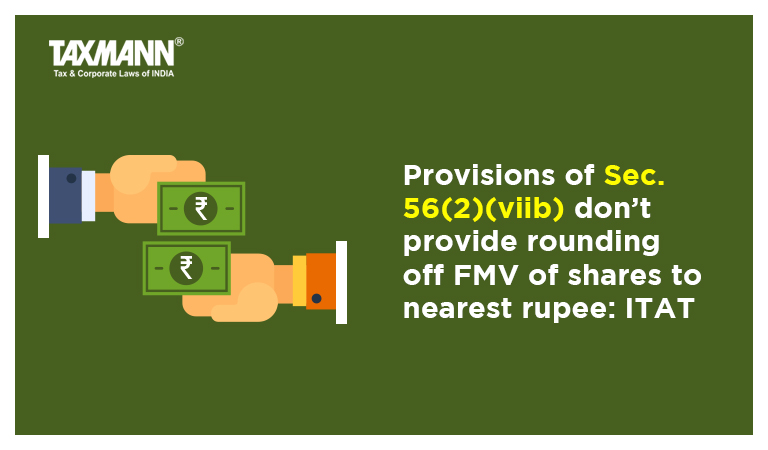Provisions of Sec. 56(2)(viib) don’t provide rounding off FMV of shares to nearest rupee: ITAT
- Blog|News|Income Tax|
- 3 Min Read
- By Taxmann
- |
- Last Updated on 28 June, 2022
Case Details: Royal Accord Realtors (P.) Ltd. v. DCIT - [2022] 139 taxmann.com 197 (Mumbai-Trib.)
Judiciary and Counsel Details
-
- Vikas Awasthy, Judicial Member
- Subodh Ratnaparkhi for the Appellant.
- T. Shankar for the Respondent.
Facts of the Case
The assessee was a private limited company engaged in the real estate business. Assessee issued 1,25,000 equity shares to M/s. Weeko Real Estate Pvt. Ltd at a premium. The fair market value (FMV) of the equity shares was determined in accordance with the method prescribed under Rule 11UA(c) of the Income Tax Rules, 1962.
As per the method prescribed the FMV of the share was Rs. 3,560.77 per share. While allotting the shares, the assessee rounded off the value to the nearest multiple of 100 and allotted the shares at Rs. 3,600 per share.
During the assessment, Assessing Officer (AO) treated the difference of Rs. 39 as income under the provisions of Section 56(2)(viib). On appeal, said order was confirmed by the CIT(A). Aggrieved-assessee filed the instant appeal before the Tribunal.
Before the tribunal, the assessee contended that rounding off of FMV was done with a bonafide intention, for convenience and not to take any unfair benefit. Further, FMV determined under rule 11UA(c) is akin to the provisions of sections 288A and 288B, wherein the total income computed as well as the tax payable or refund/deduction is rounded off as per respective provisions.
ITAT Held
The Tribunal held that on a plain reading of the section it emanates that addition under section 56(2)(viib) is made where the consideration for the issue of shares exceeds the FMV of the shares. There is no ambiguity in understanding the provisions on bare perusal.
The assessee had referred to the provisions of sections 288A, 288B, and sections 115VG(5) to support its action in rounding off the FMV. This argument can’t be accepted. The aforesaid sections specifically provide for rounding off. The provisions of these sections cannot be stretched so far as to take the benefit under other sections of the Income-tax Act.
The provisions of sections 288A, 288B, and 115VG(5) have specific applications at the time of final assessment/for specific tax schemes mentioned in the respective sections. They do not lay down the general principle of rounding off to the nearest rupee or multiple of ten or hundred under other sections of the Act. If the Legislatures indented to provide rounding off, they would have made specific provisions in section 56(2)(viib) as well.
For the purpose of construction of a taxing statute, the context, scheme of the relevant provision as a whole, and its purpose are relevant. Where the statute is unambiguous, recourse to beneficial/purposive interpretation cannot be taken.
In the instant case, the provisions of section 56(2)(viib) or Rule 11UA nowhere provide for rounding off to the nearest rupee or multiple of ten or hundred. The provisions are plain, clear, and unambiguous. Thus, the order passed by the AO was to be upheld.
List of Cases Reviewed
-
- Asstt. CIT v. Subhodh Menon [2019] 103 taxmann.com 15/175 ITD 449 (Mum.) (para 10) distinguished.
List of Cases Referred to
-
- Dy. CIT v. Jain Housing [2019] 109 taxmann.com 428/178 ITD 814 (Chennai – Trib.) (para 5)
- Asstt. CIT v. Subhodh Menon [2019] 103 taxmann.com 15/175 ITD 449 (Mum.) (para 5)
- H.H. Lakshmi Bai v. CWT [1994] 72 Taxman 435/206 ITR 688 (SC) (para 6)
- Shresth Dealers (P.) Ltd. v. ITO [IT Appeal No. 2517 (Kol.) of 2018, dated 7-6-2019] (para 6).
Disclaimer: The content/information published on the website is only for general information of the user and shall not be construed as legal advice. While the Taxmann has exercised reasonable efforts to ensure the veracity of information/content published, Taxmann shall be under no liability in any manner whatsoever for incorrect information, if any.

Taxmann Publications has a dedicated in-house Research & Editorial Team. This team consists of a team of Chartered Accountants, Company Secretaries, and Lawyers. This team works under the guidance and supervision of editor-in-chief Mr Rakesh Bhargava.
The Research and Editorial Team is responsible for developing reliable and accurate content for the readers. The team follows the six-sigma approach to achieve the benchmark of zero error in its publications and research platforms. The team ensures that the following publication guidelines are thoroughly followed while developing the content:
- The statutory material is obtained only from the authorized and reliable sources
- All the latest developments in the judicial and legislative fields are covered
- Prepare the analytical write-ups on current, controversial, and important issues to help the readers to understand the concept and its implications
- Every content published by Taxmann is complete, accurate and lucid
- All evidence-based statements are supported with proper reference to Section, Circular No., Notification No. or citations
- The golden rules of grammar, style and consistency are thoroughly followed
- Font and size that’s easy to read and remain consistent across all imprint and digital publications are applied








 CA | CS | CMA
CA | CS | CMA


